CRISTATE FORMS IN CRASSULACEAE FAMILY
Peter Lapshin
The plants from Crassulaceae family are the most widely spread leaf succulents in home collections. They are very enduring plants characterized by quick growth, attractive appearance and easy vegetative propagation. In cultivation there are many species of Kalanchoe, Sedum, Pachyphytum, Echeveria and some other genera of succulent plants.
The emergence of cristate form of growth especially spread among cacti is also typical for representatives of some genera from Crassulaceae family. Cristate is such a defect of a stem growth, when the apical meristem expands anomalously and new developing stems begin to broaden and flatten. Further they become sinuous as in some cacti cristate forms, when a cactus is literally "turning into brains".
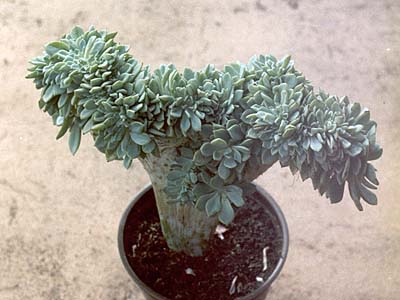 |
| Photo 1. Echeveria glauca ssp. pumila f. cristata |
Echeveria glauca ssp. pumila may be considered the most widely spread cristate among Crassulaceae family. This species preserves its cristate properties very steadily, even when reproduced from single leaves. Young rosettes may often seem normal, without any signs of cristate growth. However their further development will inevitably reveal their cristate nature. We haven't happen yet to come across a normal (non-cristate) form of this Echeveria species. The later the crest develops the more magnificent the adult plant looks.
There is another cristate Echeveria which began spreading recently which I couldn't identify yet (Echeveria sp. f. monstrosa). This species is also able to preserve its cristate properties when propagated from leaves. It differs from the previously mentioned species by thicker leaves and is rot-proof, while E. glauca ssp. pumila is often prone to rot.
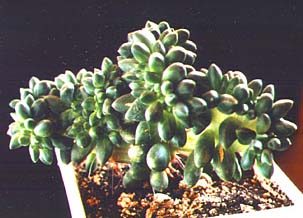 |
| Photo 3. Pachyphytum compactum f. cristata |
Sinocrassula yunnaniensis is another well-known cristate species. The plant grows fast and is capable as well of preserving its traits when propagated from leaves. The growth character of this cristate does not basically differ from that one of a normal plant. Cristate form of this species is even able to blossom – a rare enough occurrence among cristate plants.
Recently two more cristate species – Pachyphytum compactum and Sedum reflexum were imported under the "plants-from-Holland" brand. The Pachyphytum has a typical cristate form of growth and tolerates exceptionally well variations in cultivation conditions. The leaves of the cristate form are smaller in comparison with normal plants of this species; however an adult cristate plant develops more intensely than a normal one. This cristate also preserves its properties when reproduced from leaves.
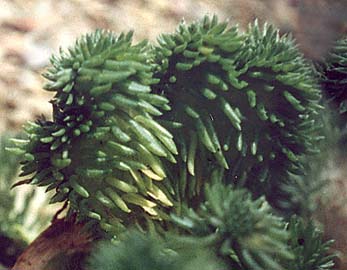 |
| Photo 4. Sedum reflexum f. cristata |
Sedum reflexum is another "Dutch" cristate. This Sedum is cultivated as an outdoor plant in climatic conditions of the central part of Russia, but it preserves its properties poorly – there are many "plain" offsets which develop a great deal faster than the crest, rapidly displacing it. Now and then cristate offsets sprout among the normal ones but they don't exceed 10%. Thus this cristate form does not reveal its properties in 100% of cases, but it doesn't also lose them completely, as it happened, for example, with cristate form of Echeveria sanguinea ssp. atropurpurea, brought by Valery Serovayskiy from California in 2000. In a year the plant completely lost all of its cristate features.
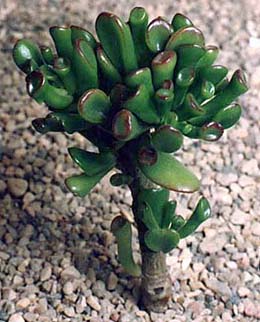 |
| Photo 5. Crassula portulacea f. monstrosa |
There are two widely spread cultivars in Crassulaceae family having the prefix "monstrosa" in the title. They are Crassula lucopodioides f. monstrosa and Crassula portulacea f. monstrosa. The first of these plants was described long ago and differs from the species norm by an irregular, as though broken stem and ruffled leaves. Sometimes it splits from the variegated form of this Crassula but being unstable in the course of growing it frequently reverts to the species norm. Crassula portulacea f. monstrosa differs from the species norm by delayed growth, far smaller size, reduced interstices and entirely dissimilar form of leaf. In contrast to the species norm with an egg-formed leaf, the monstrose form has a cylindrical and gradually broadening leaf with an indent in the end resembling a cup or a hoof. As to the name of this Crassula form there's an opinion that it is not a monstrose in traditional sense of the term but an interspecies hybrid between Crassula portulacea and Crassula lactea.
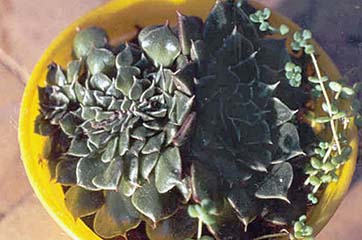 |
| Photo 6. Graptopetalum (Tacitus) bellum f. cristata |
There have been obtained a cristate form of Sedum praealtum from Nikita Botanical Gardens (Crimea, Ukraine). The cristate is distinguished by rapid growth and high tolerance to various external factors, these traits being typical also for the initial species.
In 2001 two species in the author's collection - Tacitus (Graptopetalum) bellus and Echeveria runyonii (zahnii) cv. "Topsy-turvy" – reverted accidentally to cristate forms. The cristate Tacitus was described in the two-volume edition "Succulents: Illustrated Dictionary" by Maurizio Sajeva & Mariangela Costanzo. But I haven't come across a description of cristate Echeveria zahnii in literature. The Tacitus grows rather sluggishly and lateral "normal" offsets appear regularly. The cristate Echeveria has not reached the size of an adult plant yet, however it doesn't differ from the species norm in its growth speed and responses to external influences, and that gives us some hope in further successful development of this cultivar.
REFERENCES:
- Haage Walther. Cacti / Translation from German by A. Salome; Editor D. Semyonov. - Kolos, Moscow, 1992. - 366 p.
- Maurizio Sajeva, Mariangela Costanzo. Succulents: Illustrated Dictionary. Timber Press, Portland, USA, 1994. - 239 p.
- Maurizio Sajeva, Mariangela Costanzo. Succulents: Illustrated Dictionary II. Timber Press, Portland, USA, 2000. - 234 p.





